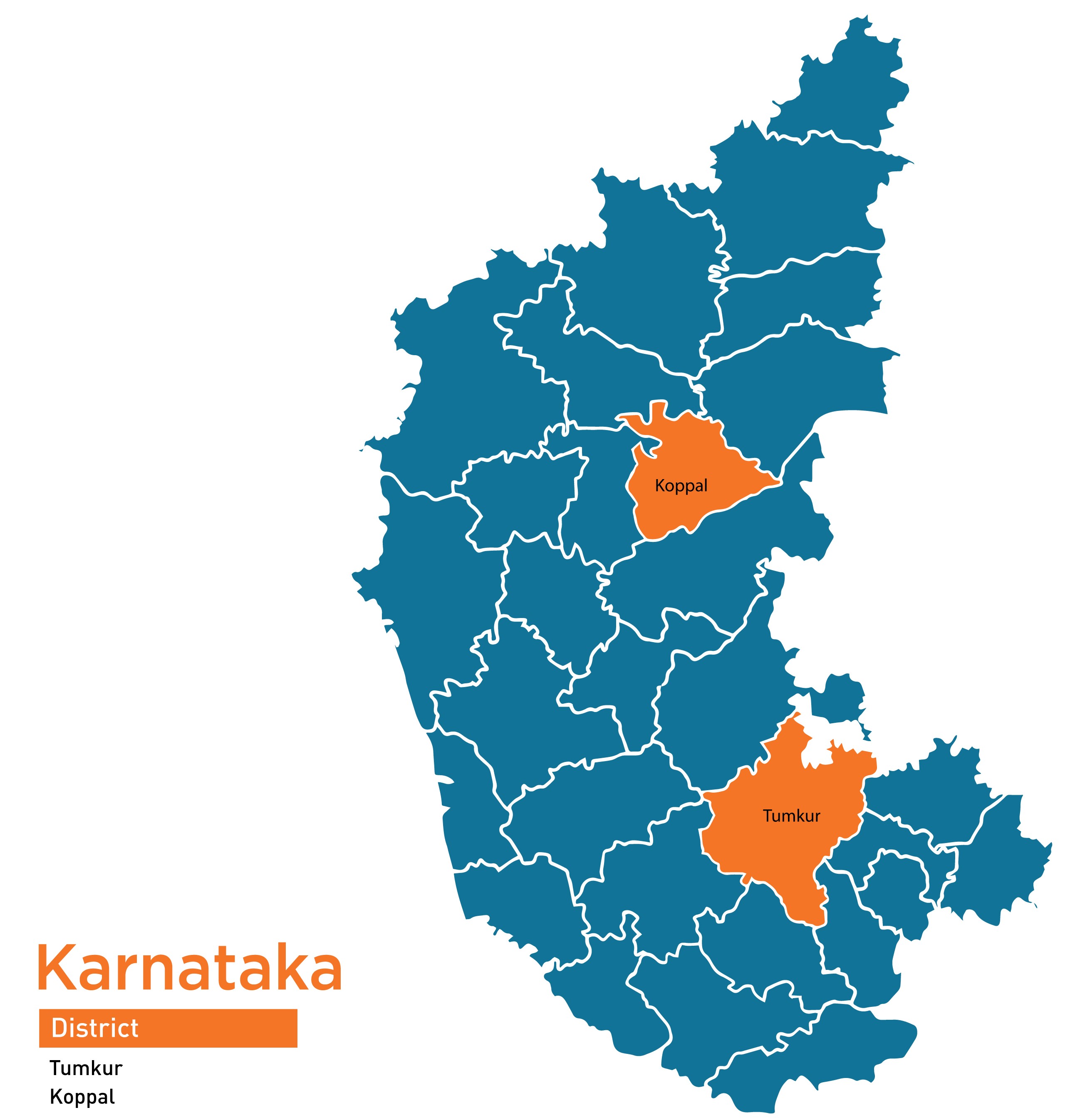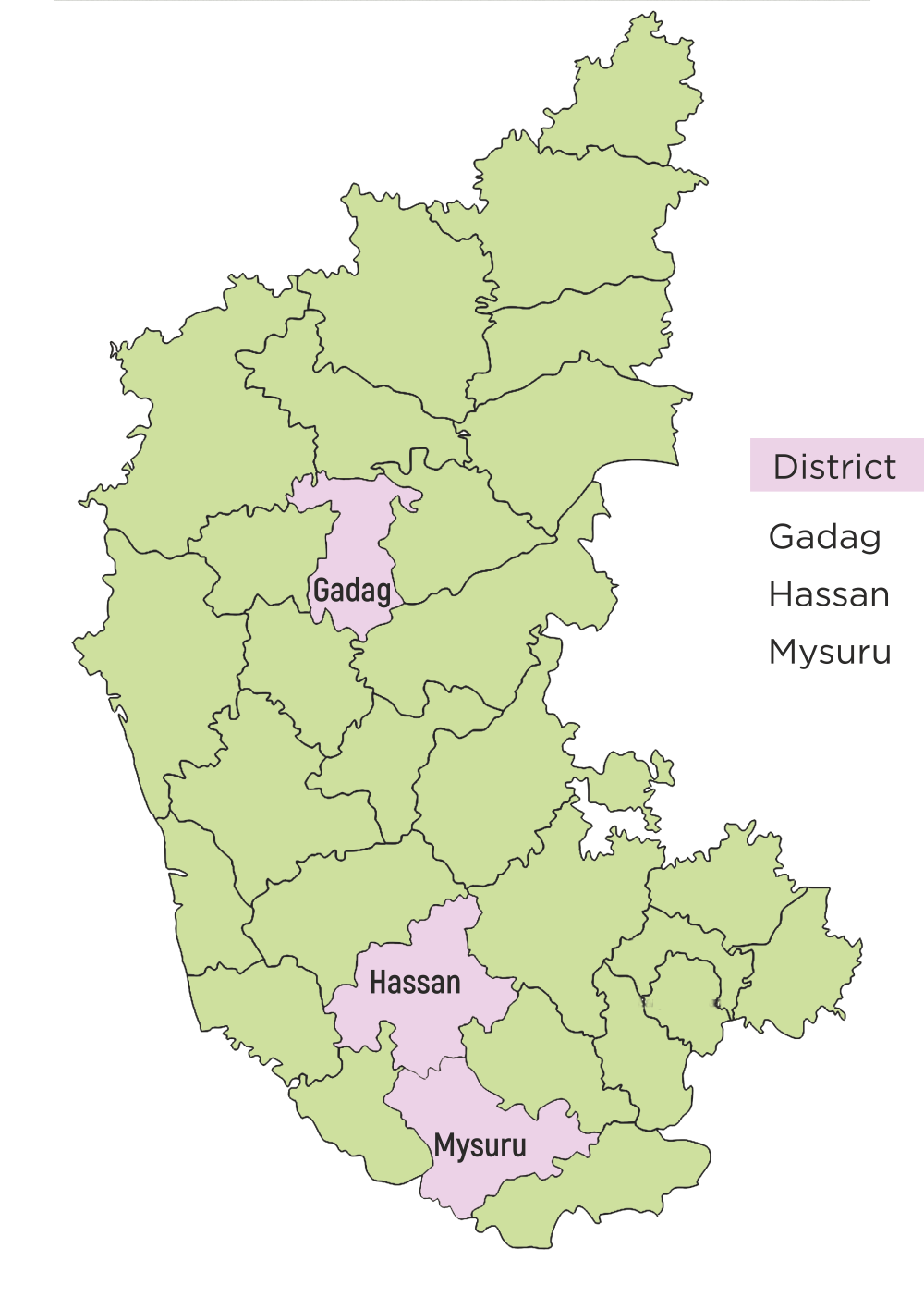Background
Karnataka, located in the south western region of India was formed on November, 1956. It is the 8th biggest state by population comprising of 6.11 crore people out of which only 38.67% people live in urban areas. The state has an SC population of 17.14% and ST population of 6.95%. It is the seventh biggest state by size with an area of 191,791 square kilometres, and covers 5.83 per cent of the total geographical area of India. The state is bordered by Arabian Sea to the west and is surrounded by six states. Karnataka is amongst one of the top states in the country with high economic growth and also has a pioneering IT industry. It has a literacy rate of 75.36% according to 2011 census. It was in the year 1993, the Karnataka Panchayat Raj Act got implemented with an objective of achieving democratic decentralization especially in the rural areas. Karnataka has been a pioneer in the SHG movement and has a history of women collectivization dating back to 1984. The state also has a rich history of entrepreneurship promotion and the RUDSETI model which took birth in a small village Ujire near Dharmasthala in Karnataka. The state has 30 districts, 176 blocks and 5635 Gram Panchayats. In Karnataka, the State Rural Livelihood Mission- Sanjeevini works for improving livelihoods and for enhancing the social and economic empowerment of the rural poor especially women.
Kudumbashree NRO has been working in Karnataka for implementing the PRI-CBO Convergence and MEC project.
PRI-CBO Convergence
The MoU of PRI-CBO convergence project with Karnataka was signed on January 20th 2014. PRI-CBO Convergence Project is running across 40 panchayats of four talukas of Koppal and Pavagada district - Koppal taluk and Gangavathi from Koppal district and Pavagada and Gubbi Taluk from Tumkur district. 10 panchayats are selected from each taluk for the project. The CBO structure of Karnataka is in such a way that SHG is at the grassroot level which federated to Ward Level Federation (WLF) at village level and a Gram Panchayat Level Federation (GPLF) at panchayat level. Local Resource Group (LRG) members are facilitators of the project activities at the grass root level providing handholding support to SHG network and PRI representatives.173 LRG’s are active in the field as of December 2016.
A field level Assessment was conducted in July 2015 after the strategy setting workshop in April 2015. Capacity building and skill training programs for Panchayati Raj members, LRG’s and CBO representatives was a continuous process throughout the project. PAE, which was named as ‘Hakkigagi Dappugalu’ was conducted in 1440 SHG’s in Karnataka followed by Entitlement access plan (EAP) preparation in 213 Ward level federation (WLF). A state level five day workshop on Grama Panchayat Poverty Reduction Plan was conducted in Koppal District Office for all the mentors in Karnataka. Mentors were oriented about the preparation of an inclusive demand plan for local development from the community itself. After their orientation, taluk wise one –day orientation was given to the LRG’s of both Koppal and Gangavathi Taluka. SHG plan includes household demands for Livelihood, Entitlement and social inclusion. All 40 panchayats of all talukas prepared the GP2RP plan. Gram Panchayat Coordination Committee was also formed in 14 panchayats in Karnataka.
| Domain Footprint | |
|
Districts |
2 |
|
Blocks |
4 |
|
Gram Panchayats |
40 |
|
SHGs in each block |
1482 |
|
Local Resource Groups (LRG) |
173 |
|
Internal mentors |
- |
|
Mentors |
15 |
MEC Project
The pilot phase of MEC project in Karnataka was implemented in three pilot districts - Gadag, Hassan and Mysuru. Key activities /tasks of the partnership included
- Project initiation and preparatory activities
- Identification and selection of MECs
- Training and capacity building
- Enterprise Benchmark and Performance Tracking System
- MEC business plan and placement of MECs
- Functioning of MEC groups and Monitoring
- Monitoring and Reporting
- Evaluation and Learning
- Policy and Support Initiatives.
Summary of ME Development Achievements
- Total of 3521 micro enterprises have been supported by the MECs from the three pilot districts
- 3657 entrepreneurs.
- The 3441 supported micro enterprises have a capital investment of 15.12 crore.
- The major sources of capital include
- Own contribution by entrepreneurs
- Loan from SHG and Banks
- State programs like RGCY
- Community Investment Fund (CIF)
- Local resources, local demand and local skills to develop sustainable local micro enterprises.
- Enterprises promoted according to local need and opportunity: weekly market, Micro poultry Unit etc.
- A total of 27 weekly markets, 6 Sanjeevini Sales points in existing markets and 4 melas have been started in Gadag.
- More than 540 SHG entrepreneurs are engaged in these markets.
- Markets sustainable and growing in size, 14 markets have crossed 1 year. Total average sales of all markets till date has crossed Rs. 10.5 crore.
- More than 170 Backyard country chicken units started in Hassan.
| Domain Footprint | |
|
Districts |
3 |
|
Blocks |
20 |
|
Micro Enterprise Consultants (MEC) |
83 |
|
Micro Enterprise Consultant Groups |
9 |
|
Micro Enterprises promoted |
3521 |
|
Mentors |
6 |